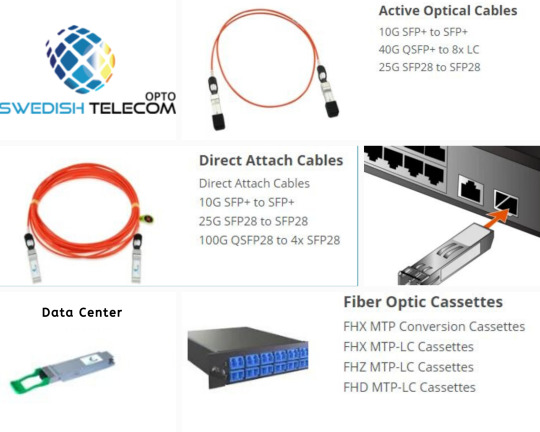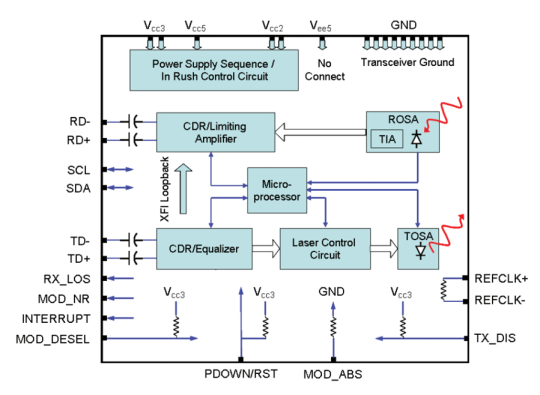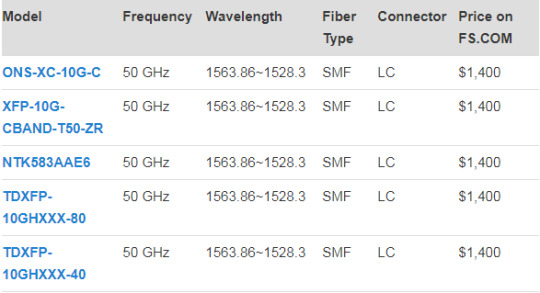#Tunable XFP DWDM
Explore tagged Tumblr posts
Photo

Are you looking for data center, DWDM OR Fiber Optic Cassettes, Active Optical Cables, Direct Attach Cables then Swedish Telecom OPTO is a one-stop destination for all your needs for Networking electronics. Buy 100G QSFP28 SR4 100m MTP/MPO Connector from Swedish Telecome at reasonable prices. Contact us Today!
1 note
·
View note
Text
10G DWDM Tunable XFP - Up to 80 km Reach
With the spread of cloud computing and mobile broadband service, the volume of communications traffic has rapidly increased. In order to enable high-capacity optical networks, using a single optical fiber for optical signals of several different wavelengths in DWDM system is widely used. For this reason, tunable transceiver that enables ROADM functionality in next-generation networks is becoming more and more popular. In today’s market, there are mainly two kinds of tunable DWDM transceivers: tunable XFP and tunable SFP+. This article will take you to explore the DWDM C-band tunable XFP transceiver with 40 / 80 km transmission distance options.

Tunable XFP Transceiver
Tunable XFP transceiver is an integrated fiber optic transceiver that provides a high-speed serial link at signaling rates from 9.95 Gbps to 11.35 Gbps. It complies with the ITU-T G.698.1 S-D100S1-2D standard with 50GHz channel spacing for SONET/SDH, IEEE DWDM 10GBASE-ZR for 40 or 80 km reach (Ethernet), and DWDM 10G FC (Fibre Channel) for 40 or 80 km reach applications. Tunable XFP can be tuned from channel C17 (1563.86nm) to C61 (1528.38nm). The maximum distance of this transceiver on a single mode fiber is up to 80 km. As mentioned above, tunable XFP optical transceiver is a full-duplex serial electric, serial optical device with both transmit and receive functions contained in a single module. On the transmit side, the 10 Gbps serial data stream is recovered, retimed, and passed to a modulator driver. The modulator driver biases and modulates a C-band-tunable integrated laser Mach-Zehnder (ILMZ), enabling data transmission over singlemode fiber through an industry-standard LC connector. On the receive side, the 10 Gbps optical data stream is recovered from an APD/transimpedance amplifier, retimed, and passed to an output driver. This module features a hot-pluggable XFI-compliant electrical interface. Here is a simple picture showing its working process.

Tunable XFP Optics Specifications:
50 GHz ITU channel spacing with intergrated wavelength locker
Available in all C-Band Wavelengths on the DWDM ITU grid
Available distances 40 or 80 km
Supports 9.95Gb/s to 11.35Gb/s
Built-in Digital Diagnostic Functions
Tempereature Range: -5°C to 70°C
Two Transmission Distance Options: 40 km or 80 km
There are two transmission distance options for tunable XFP transceiver: 40 km or 80 km. Tunable XFP DWDM 80 km transceiver is designed for long distance optical communications up to 80 km with signaling rates up to 10Gbps. Obviously, the main difference is transmission distance. On account that 10G tunable DWDM XFP optical transceiver provides digital diagnostic functions via a 2-wire serial interface, which allows real-time access to the following operating parameters: transmitted optical power, received optical power, transceiver temperature, laser bias current and transceiver supply voltage. Therefore, the differences between 40 km tunable XFP and 80 km tunable XFP mainly lie on theses parameters. One thing to note is that 40 km tunable XFP optics is designed with high performance PIN receiver, while the 80 km tunable XFP transceiver is APD receiver. The APD (avalanche photodiode) receiver employed in these extended-reach optical transceivers has an enhanced sensitivity to allow for these extended distance fiber runs. However, it is to be noted that the input power is typically between -7 and -24 dBm. Therefore, the receiver sensitivity between these two distance has a big difference. Generally, the max receive dBm of 40 km tunable XFP transceiver is -15, while the 80 km tunable XFP transceiver is -24. And for power budget, 40 km tunable XFP is 14dB while a distance up to 80 km is up to 22dB power budget. The following table lists the main differences.

Conclusion
In general, the channel switching of tunable switches can enable the service operators to turn up circuits faster and reduce their sparing costs dramatically in today’s DWDM systems. On the other hand, tunable transceiver is usually two or four times more expensive than the regular static DWDM optical module, because a special tunable laser is applied in it. Tunable XFP transceiver provides a full C-band window covering 1528nm to 1566nm for DWDM optical networks, which meets the need of rapid increase in the volume of communications traffic from telecom carrier and operator. The tunable DWDM XFP module can replace the fixed DWDM channel XFP transceivers that are currently used, while reduce the large stock since all wavelengths can now be covered with one transceiver module.

0 notes
Text
Getting to Know About DWDM Tunable Transceiver
DWDM (Dense Wavelength Division Multiplexing) technology offers a great way to boost channel capacity and transmission speed for optical systems. And it has been used in many applications, especially in long haul transmissions. In these applications, DWDM optic transceiver plays an important role. This post intends to introduce a special kind of DWDM transceiver—tunable transceiver.
What Is a DWDM Tunable Transceiver?
DWDM tunable transceiver is a unique transceiver that can select the channel or “color” the laser emits. Put it in simple terms, most WDM systems generally use optical transceivers with a fixed wavelength. That means there is a spare for each wavelength in use. But tunable transceiver has the capacity to adjust the wavelength of the transceiver on-site to meet different requirements. That’s the most distinguished point of tunable transceivers. Another characteristic of tunable transceivers is that the tunable function only lies in DWDM system due to the dense wavelength grid of DWDM.
Typically the tunable transceivers are for the C-band 50GHz. Around 88 different channels can be set with intervals of 0.4nm, which is the 50GHz band. These optics usually start from channel 16 up to 61 but this depends on the manufacturer’s router/switch and which channels it supports. And the transmission distance of DWDM tunable transceiver over single mode fibers is up to 80km and data speed is up to 10Gbps.
In addition, the DWDM tunable transceivers are available for a wide range of equipment like routers, switches and servers. With these transceivers, network operators can change wavelengths unlimited within the C-band DWDM ITU grid.
Types of DWDM Tunable Transceiver
In today’s market, there are mainly two kinds of DWDM tunable transceivers.
Tunable XFP transceiver
Tunable XFP transceiver are manufactured with an integrated full C-band tunable transmitter and a high performance receiver. Wavelengths can be set as default in 50GH DWDM ITU grid. The maximum distance of this transceiver on a single mode fiber is up to 80km. In the market, different manufactures may name tunable XFP transceiver in different forms. For example, Cisco may name it as “ONS-XC-10G-C” while Juniper version is “XFP-10G-CBAND-T50-ZR”. Besides, this transceiver be tuned in different ways.
Tunable SFP+ Transceiver
The tunable SFP+ optical transceiver is a full duplex serial electric, serial optical device. Its transmit and receive functions are contained in a single module that provides a high-speed serial link at 9.95 to 11.3Gbps signaling rates. And the transceiver supports the enhanced SFP+ specification. Here is a simple picture showing its working process.
On the transmit side, the serial data are passed from the electrical connector to a modulator driver. The modulator driver modulates a C-band cooled tunable transmitter, enabling data transmission over up to 80km on single mode fiber through an industry standard LC connector. On the receive side, the 10G optical data stream is recovered from an APD through a transimpedance amplifier to the electrical connector.
Benefits of DWDM Tunable Transceiver
Tunable transceivers have progressed rapidly in recent years. They have become popular in DWDM transmission systems because of their multi-faceted abilities and ease of spare use. Especially when combined with ROADM (reconfigurable optical add-drop multiplexers), DWDM tunable transceivers become a powerful transmission component. In simple terms, DWDM tunable transceivers have benefits below.
A wide tuning range. Compared with common fixed wavelength optical transceivers, DWDM tunable transceivers can save time and money in the long run.
Be more suitable for 100G systems by reducing line-width. The ability to adjust wavelengths provides more convenience to fit different transmitting needs.
Tunable lasers are capable of switching wavelengths in just nanoseconds. Tunable laser is a vital part of tunable transceivers. It is a high-speed and high-performance optics, enabling the needed wavelength to be reprogrammed in seconds.
Summary
DWDM tunable transceivers are able to function on various wavelengths and to adjust wavelengths according to users’ needs, making them prevalent among DWDM systems. This article mainly introduces the basis and two types of DWDM tunable transceivers. If you want to know more about it, please visit FS.COM.
Sources:http://www.chinacablesbuy.com/getting-know-dwdm-tunable-transceiver.html
0 notes
Text
The ABCs of Tunable SFP+ & Tunable XFP DWDM Optics
The ABCs of Tunable SFP+ & Tunable XFP DWDM Optics
Tunable XFP transceiver and tunable SFP+ transceiver are the hot-swap DWDM Tunable optics used in 10Gbps SONET/SDH, Fibre Channel and Gigabit Ethernet applications. Tunable DWDM transceiver is a unique device which allows customers to set the channel that the laser emits. Generally, the tunable optics is for C-Band 50GHz, starting from channel 16 up to 61 (depends on the manufacturer of the…
View On WordPress
0 notes
Text
CWDM/DWDM ITU Channel Руководство
CWDM (Грубое Спектральное Мультиплексирование) и DWDM (Плотное Волновое Мультиплексирование) позволяют носителям предоставлять больше услуг по своей существующей волоконной инфраструктуре путем объединения нескольких длин волн на одном волокне. FS предлагает серию решений и товаров CWDM/DWDM, которые помогают снизить выделение волокон надежным и экономичным способом.
CWDM ITU Channel Обзор
ITU-T G.694.2 определяет длину волны 18 (C1-C18) для CWDM передачи в диапазоне от 1270 до 1610 нм, разнесенных на расстоянии 20 нм. Ниже представлена полная сетка CWDM. Каждый канал CWDM прозрачен для скорости и типа данных, означая, что любое соединение SAN, WAN, голосовых услуг и видеоуслуг может транспортироваться одновременно по одному волокну или паре волокон.
Быстрый Просмотр FS CWDM Оптического Модля
FS CWDM модули доступны со всеми 18 длиной волны CWDM, включая CWDM SFP, CWDM SFP+, CWDM XFP и 3G SDI CWDM SFP модули. Эти трансиверы CWDM могут применяться при передаче данных с 20 до 120 километров.
20KM CWDM Модули
CWDM SFP 20KM
CWDM SFP+ 20KM
CWDM XFP 20KM
3G SDI CWDM SFP 20KM
40KM CWDM Модули
CWDM SFP 40KM
CWDM SFP+ 40KM
CWDM XFP 40KM
3G SDI CWDM SFP 40KM
80KM CWDM Модули
CWDM SFP 80KM
CWDM SFP+ 80KM
CWDM XFP 80KM
120KM CWDM Модули
CWDM SFP 120KM
FS CWDM Mux/Demux Решение
В дополнение к различным модулям CWDM/DWDM, FS также предоставляет широкий спектр модулей CWDM Mux/Demux, который выступает в качестве основного структурного элемента при расширении и обновлении сети. FS CWDM Mux/Demux имеет несколько разных типов в отношении типа линии, номера канала и специальных портов.
DWDM ITU Channel Обзор
ITU G.694.1 стандартный ре��ион DWDM составляет от 1528,77 нм до 1563,86 нм, который находится в основном в диапазоне C. DWDM может иметь интервал длин волн 100 ГГц (0,8 нм) для 40 каналов или интервал 50 ГГц (0,4 нм) для 80 каналов. Ниже показана полная сетка каналов для DWDM 100 ГГц.
Быстрый Просмотр FS DWDM Оптического Модля
FS CWDM модули доступны со всеми 44 длинами волн DWDM, включая DWDM SFP, DWDM SFP+, DWDM XFP и Tunable DWDM модули, которые поддерживают дальность передачи данных макс.до 120 км. Перестраиваемые модули Tunable (DWDM) могут способен поддерживать определенный канал в оптической сети DWDM, позволяя удаленно изменять длины волн в программном обеспечении.
40KM DWDM Модули
DWDM SFP 40KM
DWDM SFP+ 40KM
DWDM XFP 40KM
80KM DWDM Модули
DWDM SFP 80KM
DWDM SFP+ 80KM
Tunable DWDM SFP+ 80KM
DWDM XFP 80KM
Tunable DWDM XFP 80KM
120KM DWDM Модули
DWDM SFP 120KM
FS DWDM Mux/Demux Решение
DWDM Mux/Demux используется в сетях дальнего расстояния, чтобы облегчить истощение волокна и затраты, связанные с запуском нового волокна. Каждый канал DWDM может передать данных макс.до 100G, а расстояния более 1000 километров могут быть достигнуты с использованием оптических усилителей.
CWDM ITU Channel
0 notes
Text
The 5 advantages of DWDM technology networks
Optical Networks offer a wide variety of features and possibilities for a stable and high-speed network. One of those features is the Dense Wavelength Division Multiplexing or DWDM technology. This technology converts data that comes from different sources together on the same optical fiber, however each optical signal is carried on its own optical wavelength. Using this technology, today, up to 32 optical wavelengths can be driven on one and only optical fiber.
GBIC-SHOP Blueoptics© offer a range of Optical Transceivers that can support DWDM technology. DWDM SFP transceivers are used for bandwidth up to 3GB/s, DWDM XFP transceivers are used for bandwidth up to 11.3 GB/s, DWDM SFP+ transceivers are used for bandwidth up to 10.3 GB/s. Across all of these there is an option of choosing models with fixed DWDM settings if needed. However, a more flexible solution exists with the introduction of Tunable XFP or Tunable SFP+ transceivers which offer the possibility to set the wavelength range according to the transceiver used. Read More.
https://www.gbic-shop.de/blog/en/102-dwdm/298-the-5-advantages-of-dwdm-technology-networks.html
0 notes
Text
The 5 advantages of DWDM technology networks
Optical Networks offer a wide variety of features and possibilities for a stable and high-speed network. One of those features is the Dense Wavelength Division Multiplexing or DWDM technology. This technology converts data that comes from different sources together on the same optical fiber, however each optical signal is carried on its own optical wavelength. Using this technology, today, up to 32 optical wavelengths can be driven on one and only optical fiber.
GBIC-SHOP Blueoptics© offer a range of Optical Transceivers that can support DWDM technology. DWDM SFP transceivers are used for bandwidth up to 3GB/s, DWDM XFP transceivers are used for bandwidth up to 11.3 GB/s, DWDM SFP+ transceivers are used for bandwidth up to 10.3 GB/s. Across all of these there is an option of choosing models with fixed DWDM settings if needed. However, a more flexible solution exists with the introduction of Tunable XFP or Tunable SFP+ transceivers which offer the possibility to set the wavelength range according to the transceiver used. Read More.
https://www.gbic-shop.de/blog/en/102-dwdm/298-the-5-advantages-of-dwdm-technology-networks.html
0 notes
Text
The 5 advantages of DWDM technology networks
Optical Networks offer a wide variety of features and possibilities for a stable and high-speed network. One of those features is the Dense Wavelength Division Multiplexing or DWDM technology. This technology converts data that comes from different sources together on the same optical fiber, however each optical signal is carried on its own optical wavelength. Using this technology, today, up to 32 optical wavelengths can be driven on one and only optical fiber.
GBIC-SHOP Blueoptics© offer a range of Optical Transceivers that can support DWDM technology. DWDM SFP transceivers are used for bandwidth up to 3GB/s, DWDM XFP transceivers are used for bandwidth up to 11.3 GB/s, DWDM SFP+ transceivers are used for bandwidth up to 10.3 GB/s. Across all of these there is an option of choosing models with fixed DWDM settings if needed. However, a more flexible solution exists with the introduction of Tunable XFP or Tunable SFP+ transceivers which offer the possibility to set the wavelength range according to the transceiver used. Read More.
https://www.gbic-shop.de/blog/en/102-dwdm/298-the-5-advantages-of-dwdm-technology-networks.html
0 notes
Text
Tunable Optical Transceivers – When To Use?
Tunable Optical Transceivers – When To Use?
by http://www.fiber-mart.com
Already for some time tunable optical transceivers for use in DWDM systems, such as XFP and SFP+ are available for optical networking industry. Current evolution of tunable optical transceivers typically support full ITU-T C-band, allowing dynamically tune transmitter wavelength with 50GHz steps. However, even longer time conventional or fixed wavelength DWDM…
View On WordPress
0 notes